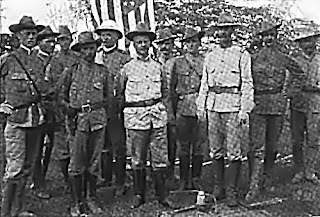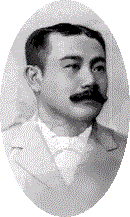 |
| Photo art: Jesusa Bernardo |
Original Photo Source: http://www.museo-oriental.es/ver_didactica.asp?clave=138&loc=0
 |
| Photo art: Jesusa Bernardo |
 |
| Imperialist U.S. Gen. John J. Pershing |
 |
| University of Santo Tomas |
 Battle of Manila that falsely showed to the world that it is the Bald Eagle soldiers and not the Philippine force that have defeated the colonial Spaniards in the Southeast Asian archipelago.
Battle of Manila that falsely showed to the world that it is the Bald Eagle soldiers and not the Philippine force that have defeated the colonial Spaniards in the Southeast Asian archipelago. |
| Imperialist U.S. Gen. Henry W. Lawton, Fil-Am War |
 |
| Gen. Leandro L. Fullon |
 |
| Hong Kong Junta (1898 photo) |
 |
| Jose Corazon de Jesus y Pangilinan |
 |
| Imperialist U.S. Gen. Arthur MacArthur |
 |
| Isabelo Artacho |
 |
| Gen-en-Geje Martin T. Delgado |
 |
| Pres. Elpidio R. Quirino |
 1935 - The American colonial-era Commonwealth of the Philippine is inaugurated with Manuel L. Quezon as President of the Philippines and Sergio Osmeña, Sr., as Vice-President; Quezon prevailed over presidential rival Emilio F. Aguinaldo, the former being the ayuda-de-campo of the latter during the Philippine-American War (1899-1914), apparently over the issue of Aguinaldo's power grab from, and execution of, the original leader of the Philippine Revolution, Andres Bonifacio y de Castro; prior to the inauguration, the Philippines had an insular colonial government, a kind of territorial colonial government that reported to the United State Bureau of Insular Affairs beginning about 1901 when the imperialist Americans began to establish themselves into the islands but the Filipino-American War still raging, mostly guerrilla-style from the end of the Filipino freedom fighters.
1935 - The American colonial-era Commonwealth of the Philippine is inaugurated with Manuel L. Quezon as President of the Philippines and Sergio Osmeña, Sr., as Vice-President; Quezon prevailed over presidential rival Emilio F. Aguinaldo, the former being the ayuda-de-campo of the latter during the Philippine-American War (1899-1914), apparently over the issue of Aguinaldo's power grab from, and execution of, the original leader of the Philippine Revolution, Andres Bonifacio y de Castro; prior to the inauguration, the Philippines had an insular colonial government, a kind of territorial colonial government that reported to the United State Bureau of Insular Affairs beginning about 1901 when the imperialist Americans began to establish themselves into the islands but the Filipino-American War still raging, mostly guerrilla-style from the end of the Filipino freedom fighters.  |
| Diego & Gabriela Silang |
 |
| Imperialist Americans in invading action |
 1855 - Mariano Llanera, future barrio chief and municipal captain, mason, patriot and general in the Philippine Revolution against Spain, is born in Aliaga, Nueva Ecija; Llanera, who would fight in the provinces of Bulacan, Pampanga, Tarlac, and Nueva Ecija, would adopt a revolutionary black flat with a white letter K on the left and a white skull atop a cross of two bones, the design of which was based from the initiation rites of the secret-society-later-turned-revolutionary-government Kagalanggalangang Katipunan nang manga Anak nang Bayan (KKK), and which Supremo Andres Bonifacio would refer to as "Bungo ni Llanera" or Llanera's Skull; Llanera, would also be known for leading the "first cry of Nueva Ecija" in Cabiao, Nueva Ecija on September 2, 1896, a victorious attack on the local Spanish government that signaled the participation of the province in the Revolution.
1855 - Mariano Llanera, future barrio chief and municipal captain, mason, patriot and general in the Philippine Revolution against Spain, is born in Aliaga, Nueva Ecija; Llanera, who would fight in the provinces of Bulacan, Pampanga, Tarlac, and Nueva Ecija, would adopt a revolutionary black flat with a white letter K on the left and a white skull atop a cross of two bones, the design of which was based from the initiation rites of the secret-society-later-turned-revolutionary-government Kagalanggalangang Katipunan nang manga Anak nang Bayan (KKK), and which Supremo Andres Bonifacio would refer to as "Bungo ni Llanera" or Llanera's Skull; Llanera, would also be known for leading the "first cry of Nueva Ecija" in Cabiao, Nueva Ecija on September 2, 1896, a victorious attack on the local Spanish government that signaled the participation of the province in the Revolution.  1899 - San Jose, Nueva Ecija is captured by enemy American invaders apparently without resistance nine months into the bloody and protracted Philippine-American War (1899-1914); the capture comes nearly a month after the imperialist United States forces started a major offensive that involved the influx of troops in the bid to invade the Southeast Asian archipelago, with Philippine President Emilio Aguinaldo y Famy going into hiding and further retreating northwards; the Filipino freedom fighters in much of Luzon and also the Visayas and Mindanao islands would later stage guerilla-style defense of their motherland against the imperialist Bald Eagle for well over a decade.
1899 - San Jose, Nueva Ecija is captured by enemy American invaders apparently without resistance nine months into the bloody and protracted Philippine-American War (1899-1914); the capture comes nearly a month after the imperialist United States forces started a major offensive that involved the influx of troops in the bid to invade the Southeast Asian archipelago, with Philippine President Emilio Aguinaldo y Famy going into hiding and further retreating northwards; the Filipino freedom fighters in much of Luzon and also the Visayas and Mindanao islands would later stage guerilla-style defense of their motherland against the imperialist Bald Eagle for well over a decade.  |
| Aniceto Lacson y Ledesma |
| Biak-na-Bato Generals & Negotiator Pedro Paterno |
 1841 - Filipino religious leader and martyr Apolinario de la Cruz, also known as Hermano Pule, is executed by colonial Spanish authorities; de la Cruz , whose dream of being a priest was frustrated by the discriminatory colonial policies of the Spanish friars, co-founded the brotherhood Cofradia de San Jose that was initially a Catholic religious brotherhood that swelled in membership; de la Cruz's execution came following a failed rebellion as the religious group's reaction to friar attempts to suppress the Cofradia.
1841 - Filipino religious leader and martyr Apolinario de la Cruz, also known as Hermano Pule, is executed by colonial Spanish authorities; de la Cruz , whose dream of being a priest was frustrated by the discriminatory colonial policies of the Spanish friars, co-founded the brotherhood Cofradia de San Jose that was initially a Catholic religious brotherhood that swelled in membership; de la Cruz's execution came following a failed rebellion as the religious group's reaction to friar attempts to suppress the Cofradia.  1762 - The Pangasinan Revolt led by Juan de la Cruz Palaris erupts in Binalatongan during the Spanish colonial rule of the Philippines; the revolt under Palaris (born as Pantaleon Perez), the second revolt in the province of Pangasinan during the Spanish era that coincided with the British invasion of the Philippines, would spread to the towns of Mangaldan, Calasiao, Dagupan, San Jacinto, Sta. Barbara, Manaoag, Bayambang, Malasiqui, and Paniqui; however, with the signing of the 1763 Treaty of Paris that ended the Seven-Year War between Spain and Britain, along with the successful suppression of the Silang Revolt in Ilocos, the colonial Spanish authorities were able to concentrate on Pangasinan, eventually quashing the rebellion and soon hanging Palaris.
1762 - The Pangasinan Revolt led by Juan de la Cruz Palaris erupts in Binalatongan during the Spanish colonial rule of the Philippines; the revolt under Palaris (born as Pantaleon Perez), the second revolt in the province of Pangasinan during the Spanish era that coincided with the British invasion of the Philippines, would spread to the towns of Mangaldan, Calasiao, Dagupan, San Jacinto, Sta. Barbara, Manaoag, Bayambang, Malasiqui, and Paniqui; however, with the signing of the 1763 Treaty of Paris that ended the Seven-Year War between Spain and Britain, along with the successful suppression of the Silang Revolt in Ilocos, the colonial Spanish authorities were able to concentrate on Pangasinan, eventually quashing the rebellion and soon hanging Palaris.  |
| Patriot Julio Nakpil y Putco |
 |
| Raja Lapu-Lapu slays Ferdinand Magellan |